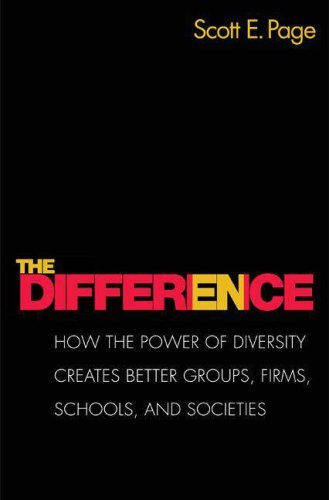Reviewed by
Bruce Edmonds
Manchester Metropolitan University
 This book is an argument for the importance of diversity in society. It is not naive, in the sense that it does not argue that any diversity is helpful, but rather tries to distinguish some of the ways in which it can be helpful and, hence, some the conditions under which it can be helpful. It does this is a largely non-technical language and using informal argument using argument, examples and a review of the evidence to support its conclusions. It ends with some policy suggestions, particularly in terms of university admission and job recruitment.
This book is an argument for the importance of diversity in society. It is not naive, in the sense that it does not argue that any diversity is helpful, but rather tries to distinguish some of the ways in which it can be helpful and, hence, some the conditions under which it can be helpful. It does this is a largely non-technical language and using informal argument using argument, examples and a review of the evidence to support its conclusions. It ends with some policy suggestions, particularly in terms of university admission and job recruitment.
The book is somewhat frustrating for the social simulator, because although all the arguments and results were suggested by and underpinned by simulations, these are not described or discussed in this book. Rather the ideas gained from these are abstracted to worked examples and more general arguments which are what is presented here. As the author says:
"For those more mathematically inclined readers (hint: my professional colleagues), accept in advance this apology for the necessary overgeneralisations. Many of the claims in the book can be stated with greater clarity and precision. Those who want the details in more detail can peruse the academic papers that Lu Hong, Jenna Bednar, and I have written in the stark, cold language of the academy."
Carrying on somewhat alarmingly:
"These papers ... contain the mathematical chest thumping - the epsilons and sigma algebras - that one expects from a card-carrying mathematical social scientist."
Thus an experienced social simulator might get more out of reading the papers he refers to above (Page 1996; Hong and Page 2001; Hong and Page 2004; Hong and Page 2005; Page and Bednar 2006) which are all available at the author's web page ( http://www.cscs.umich.edu/~spage/).
The book distinguishes between cognitive diversity - the mental "tool box" that is used in problem solving - and preference diversity - the differences in what people want. Broadly the claim of the book is that groups of cognitively diverse problems solvers can do better than a group of "cleverer" problem solvers for difficult problems, because in the later case many will be searching the same area of the problem space, whilst the former has a better chance that one of them will discover the best possible solution. This problem-solving tool box is modelled to separate out different aspects of diversity: perspectives, interpretations, heuristics and predictive models. The book uses examples and arguments to show that diversity in each of these can be help for certain kinds of problem.
In contrast, preference diversity is presented as problematic in a situation where a single solution has to be decided for all in the group. Classic results from voting theory show that the outcome of any process to determine a common decision when there are many different preferences is potentially problematic. Thus in situations where there is a mixture of problem solving and preference conflict (as occurs in most observed situations) the benefits of diversity are difficult to distinguish from its "costs". This is used to explain the apparently contradictory or unclear evidence for the advantages of diversity in chapter 13.
One of the limitations of this work is its embedding within the Economic tradition of investigation. One is tempted to suggest that a more diverse set of approaches and viewpoints might have been brought to bear. Two whole fields of relevance to this issue are (1) ecological models where the argument about the importance of diversity in the food chain is longstanding and (2) in evolutionary computing where using a diverse population to search for solutions is at the core of everything they do. However the discussion remained within the perspective of economics, with the usual structures of game theory, utilities, etc. I find the economic framework of the arguments a little constraining - for example that the target problem is one of constrained optimisation rather than, say, an open-ended creative task (like composing a poem).
The central lesson of the book, that teams can be more effective than brilliant individuals working alone, will not be surprising to anyone who is involved in social simulation. In many ways it can be seen as the old AI exploration/exploitation trade-off, but between individuals. However the book does try to go beyond this and start to unpack the different strands that are entwined in the diversity debate, in particular separating cognitive and group-based diversity (where most of the political debate is situated) as well as problem-solving and preference accommodation. The surface non-simulation approach is frustrating, especially since they are replaced with lots of tabulated examples that take a similar level of work to follow. This book cries out for a web page of accessible and illustrative NetLogo simulations!
HONG L and PAGE SE (2004) Groups of Diverse Problem Solvers Can Outperform Groups of High-Ability Problem Solvers. Proceedings of the National Academy of Sciences, 101 (46): 16385-89.
HONG L and PAGE SE (2005) Interpreted and Generated Signals. Working paper, University of Michigan-Ann Arbor.
PAGE SE (1996) Two Measures of Difficulty. Economic Theory 8 (2): 321-46.
PAGE SE and BEDNAR J (2006) Game(s) Theory and the Emergence of Culture. Rationality and Society, 18 (2).
Return to Contents
of this issue
© Copyright Journal of Artificial Societies and Social Simulation, 2008